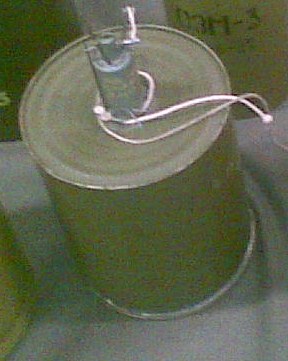M16 (mine)
| M16 (mine) | |
|---|---|
| General Information | |
| Designation: | M16, M16A1, M16A2 |
| Type: | Anti-personnel mine |
| Country of origin: | United States |
| Technical specifications | |
| Combat weight: | 4.1 kilograms |
| Charge: | 575 grams of TNT |
| Diameter: | 103 millimeters |
| Height: | 203 millimeters |
| Detonator: | Chemical pressure igniter |
| Lists on the subject | |
The anti-personnel mine M16 is an American-made jumping mine . It consists of a cylindrical metal body and is reminiscent of a large tin can without a fuse. It is laid manually by infantrymen and is the primary anti-personnel mine for the US armed forces .
history
The mine was developed in the 1950s and is based on a German S-mine from WWII . It has been continuously developed and the current version is the M16A2.
Detonator
The M605 igniter is screwed into the top of the mine and reacts to pull or pressure . The detonator has three upright antennas which, depending on the setting, ignite the mine at a force of 35–90 Newtons . The detonator can also be connected with trip wires. Depending on the setting, pulling 15–45 N on one of the tripwires is sufficient to ignite the mine.
effect
If the detonator is triggered, the outer container separates (remains in the ground) from the fragmentation jacket with the active charge. When a small ejection charge is ignited, it jumps approx. 0.8 meters into the air and detonates after the main charge is ignited, forming splinters. The outer container remaining in the ground is connected to the functional part by a thin, approx. 80 cm long wire rope. When the wire rope is tensioned, an internal percussion fuse is tensioned, which releases locking balls at a defined point, which release the then pre-tensioned firing pin. This firing pin then ignites the real charge. The splinters spread in a ring and are considered deadly within a radius of about 30 meters. Jumping up in the air makes the mine more deadly in two ways. The splinters have a greater range than if they were ignited on the ground, and the ring-shaped splinter cloud does not hit the victim primarily on the feet or legs, as in a conventional AP mine, but on the body, the damage of which has worse consequences in the abdomen , Upper body and head.
Humanitarian point of view
Like all mines, the M16 is basically just as dangerous for civilians and animals as it is for soldiers. The M16 is easy to locate with a metal detector and, assuming the necessary caution, can also be discovered with the naked eye, but people in the areas of operation of the M16 lack the knowledge or the education to find one; neither do they anticipate the presence of mines. The mine is protected against being picked up by a booby trap. The M16 does not self-destruct for a given time and lasts eight years in moderate climates with clay soil with only 30% expected failure rate and in hot, dry surroundings even significantly longer.
Versions
The M16, M16A1 and M16A2 mines differ primarily only in the construction of the explosive charge and the jumping charge. In the M16A2, its range has been noticeably increased compared to the previous models.
use
The M16 is intended to create obstacles for an advancing enemy or to make it difficult for them to enter an area. They also serve to secure anti-tank mines against mine clearance troops and the moral decomposition of the enemy.
